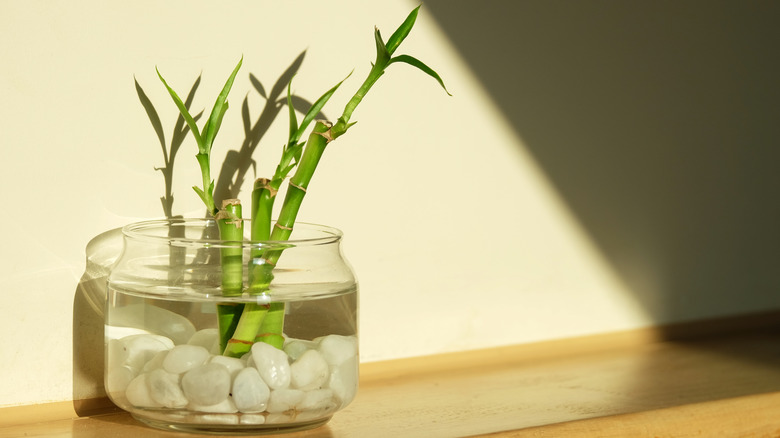Lucky Bamboo: Everything You Should Know Before Planting
Down on your luck? Maybe you need some Dracaena sanderiana or lucky bamboo. This plant, which originated in Southeast Asia, channels good fortune and allegedly offers health, love, and luck to those that own it. For more than 5,000 years, practitioners of feng shui — the art of space arrangement to optimize balance and harmony — have upped positivity in their homes and offices with this bit of "luck," per ProFlowers.
At first, lucky bamboo might look like naked branches. As the plant grows, long wisps of leaves begin to appear along the top of each stalk; these can become quite lush over time since they can expand up to one inch each month. If you cut these stalks, they cease to grow — so wait to trim until the plant reaches the desired height. You can also manipulate the stalks into graceful curved and twisting shapes with wire as they becomes taller.
Lucky bamboo, which goes by lots of nicknames — such as curly bamboo, Chinese water bamboo, friendship bamboo, Goddess of Mercy, Belgian evergreen, and ribbon plant — grows indoors. Despite its name, the plant is related to the lily and not the bamboo family, said Den Garden. Growing one is simple since it's low maintenance and fares well in soil or water, and rarely needs fertilizer. So if you want more luck in your life, here is how to keep a lucky bamboo thriving.
How to grow lucky bamboo
You can grow lucky bamboo hydroponically or in soil. With water, you should put 1 to 3 inches in a dish or bowl and anchor your plant with pebbles, rocks, or marbles. You'll need to refresh the H2O every two to four weeks. To create full leaves, increase the water level — the higher on the stalk it touches, the more the roots grow and that facilitates vibrant foliage. With soil, keep the roots covered, and water often; you want the dirt to feel damp, but not sodden, according to Gardening Know How.
You can grow the plant from seeds or cuttings. One nice thing about lucky bamboo is it propagates easily. Here's how: Cut a healthy stalk off of an existing plant with pruning shears, and make sure it contains at least two segments to promote proper growth. Remove any leaves from the bottom and put it into two inches of distilled water (BTW, filtered or distilled water is always best since fluoride — often put into the tap variety — can turn leaves brown). If you're lucky, in a few weeks you'll see roots and leaves develop ... and presto, a new lucky bamboo plant arrives (per Hunker).
Growing from seeds is a harder path. You should soak freshly collected seeds in warmed distilled water (85 degrees Fahrenheit) for 24 hours before putting them in potting soil. These must be kept warm and exposed to indirect light until they sprout and are transplanted, said Garden Eco.
How to care for lucky bamboo
Lucky bamboo plants please easily; with regular watering, a spot with indirect light, and a liquid fertilizer every few weeks, you'll have a flourishing plant. Direct sun burns its leaves, however, so keep the container away from sunny spaces. If you see brown lining the leaves, find a new place for your lucky bamboo plant.
Overwatering soil can produce root rot so keep soil wet, but not waterlogged. For plants living in water containers, keep those roots covered and the H2O fresh, and change the water every week or so. You also keep lucky bamboo warm, say 65 to 95 degrees Fahrenheit.
Lucky bamboo should remain green, so if you see it yellowing that means something is wrong. Remove any tainted leaves or stems so the ailment won't spread. Any grey fuzz — indications of a fungal infection — should also be taken away. You also want to keep the plant dry and give it more air circulation, explains ProFlowers.
Varieties of lucky bamboo
One fun thing about lucky bamboo is you can create all sorts of configurations from its varieties, which include:
- White stripe victory, which is just like it sounds: decorated with fine white stripes along its leaves. The plant adores the shade.
- White stripe gold is like a cousin of victory, except yellow edges the leaves.
- Green wears the title of most popular and comes in single or multiple stalks, said Balcony Garden Web.
Much like bonsai, lucky bamboo can retain shapes. Try using a wire/twist tie to create designs, or harness the sun and make your bamboo grow toward the light, reported The Farmer's Almanac.
- Curves/spirals — To make your plant curve, you need a cardboard box larger than your plant and a light source. Remove the bottom and one side. Face the opened end to the light and put the plant into the box. You'll see the bamboo growing towards the light. Adjust the plant regularly and you'll create a curve. Moving it more often will make that turn tighter; longer intervals generate looser spirals (from Bamboo Plant HQ).
- Heart — This works similar to the method above. With the heart, you'll tie two similar sized stalks at the bottom and then again about 3 to 4 inches from that spot. Use the cardboard to target the light on one section to form a curve. Then switch sides. Once both have a curve you like attach them together, per SF Gate.
Is lucky bamboo toxic?
For the most part, lucky bamboo, is well ... lucky for pets as well. Even the most common variety, dracaena sanderiana, is innocuous for the most part. While it can leave a mild toxicity in your digestive system when humans or their furry friends eat its leaves and stems, according to Our House Plants, lucky bamboo is not normally life threatening. Be mindful, though, of what type of lucky bamboo you have because sometimes the plant is marked Phyllostachys aurea — and that's not poisonous at all.
While not fatal if consumed, any living creature that eats dracaena sanderiana should be monitored. Lucky bamboo does contain saponins, and if enough of it is eaten, a stomachache is probable for humans, said Hunker. Pet symptoms include vomiting, diarrhea, abdominal pain, and other not-fun things.
The ASPCA points out that eating any plant parts can cause gastrointestinal trouble for nibbling cats and dogs. If you see that your pet is in distress and there is a ravaged dracaena sanderiana plant nearby, you can either call you local veterinarian or consult with the Animal Poison Control Center at 888-426-4435.
How to repot lucky bamboo
If you are changing the water of your lucky bamboo plant and find the roots are snarled and shaped like the container, it is time to re-pot your lucky bamboo. You can use two techniques to switch from the old to new receptacle: either trim the roots or find a larger pot. If you cut the roots, use sterile and sharp scissors, and make sure to leave at least one inch intact. Consider adding some fertilizer, which will stimulate the shorn roots, as noted by Lucky Bamboo Shop.
You can also introduce soil to a lucky bamboo previously sustained by water. Use potting soil and place the plant into its new home. Keep the environment moist until the roots grow a bit and then you can water less — but still maintain the slight wetness the lucky bamboo likes (per Better Homes & Gardens).
Heighten your luck by tying a red ribbon around your pot. In feng shui the color represents fire — one of the five elements (the others are wood, earth, metal, and water). The lucky bamboo already brings good fortune and adding an element only heightens that. Hedge your bets by placing your plant in the southeast corner, which traditionally magnifies wealth. With the right accouterments and placement, your lucky bamboo will bring only good things.
Lucky bamboo stalks and their special numbers
You want to pay attention to the number of stalks you have when installing a lucky bamboo plant in your home or office. For example, the feng shui element won't advise having one with four stalks since the word is associated with "death" in the Chinese culture, according to The Spruce.
To that end, here are some better stalk combinations to try. Two stalks can double your pleasure, as a duo symbolizes love and increases your luck. Three provides the key to happiness, wealth, and longevity, while five, six, and seven offer prosperity. Five also allows you to give someone the gift of success since five stalks offers wealth. It is a perfect present for someone yearning to grow their business. Additionally, six provides general luck and seven has it all: wealth, happiness, and perfect health. Eight stalks is terrific for those lacking motivation, as it ramps up your drive and luck. Nine stalks has a good, all-purpose target: passing on good fortune. If you're a perfectionist, 10 stalks is for you since it allows that very thing to form. Finally, 21 stalks invite abundance and many blessings (from Ferns n Petals).






